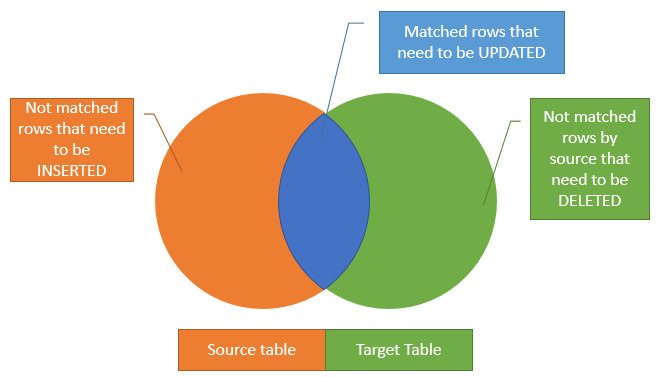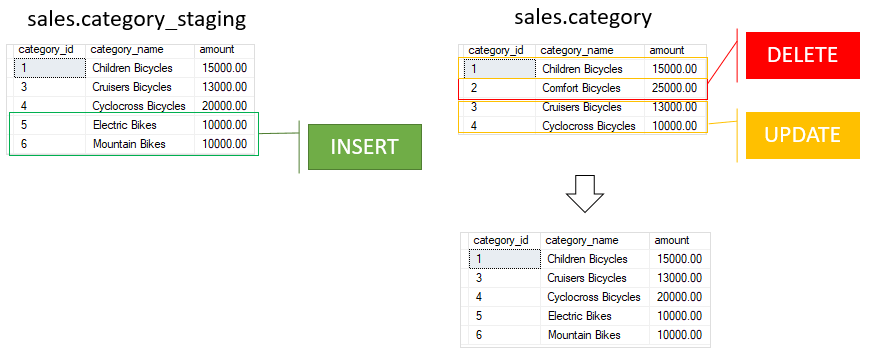Summary: in this tutorial, you will learn how to use the SQL Server MERGE statement to update data in a table based on values matched from another table.
Introduction SQL Server MERGE Statement
Suppose, you have two table called source and target tables, and you need to update the target table based on the values matched from the source table. There are three cases:
- The source table has some rows that do not exist in the target table. In this case, you need to insert rows that are in the source table into the target table.
- The target table has some rows that do not exist in the source table. In this case, you need to delete rows from the target table.
- The source table has some rows with the same keys as the rows in the target table. However, these rows have different values in the non-key columns. In this case, you need to update the rows in the target table with the values coming from the source table.
The following picture illustrates the source and target tables with the corresponding actions: insert, update, and delete:

If you use the INSERT, UPDATE, and DELETE statement individually, you have to construct three separate statements to update the data to the target table with the matching rows from the source table.
However, SQL Server provides the MERGE statement that allows you to perform three actions at the same time. The following shows the syntax of the MERGE statement:
MERGE target_table USING source_table
ON merge_condition
WHEN MATCHED
THEN update_statement
WHEN NOT MATCHED
THEN insert_statement
WHEN NOT MATCHED BY SOURCE
THEN DELETE;
Code language: SQL (Structured Query Language) (sql)First, you specify the target table and the source table in the MERGE clause.
Second, the merge_condition determines how the rows from the source table are matched to the rows from the target table. It is similar to the join condition in the join clause. Typically, you use the key columns either primary key or unique key for matching.
Third, the merge_condition results in three states: MATCHED, NOT MATCHED, and NOT MATCHED BY SOURCE.
MATCHED: these are the rows that match the merge condition. In the diagram, they are shown as blue. For the matching rows, you need to update the rows columns in the target table with values from the source table.NOT MATCHED: these are the rows from the source table that does not have any matching rows in the target table. In the diagram, they are shown as orange. In this case, you need to add the rows from the source table to the target table. Note thatNOT MATCHEDis also known asNOT MATCHED BY TARGET.NOT MATCHED BY SOURCE: these are the rows in the target table that does not match any rows in the source table. They are shown as green in the diagram. If you want to synchronize the target table with the data from the source table, then you will need to use this match condition to delete rows from the target table.
SQL Server MERGE statement example
Suppose we have two table sales.category and sales.category_staging that store the sales by product category.
CREATE TABLE sales.category (
category_id INT PRIMARY KEY,
category_name VARCHAR(255) NOT NULL,
amount DECIMAL(10 , 2 )
);
INSERT INTO sales.category(category_id, category_name, amount)
VALUES(1,'Children Bicycles',15000),
(2,'Comfort Bicycles',25000),
(3,'Cruisers Bicycles',13000),
(4,'Cyclocross Bicycles',10000);
CREATE TABLE sales.category_staging (
category_id INT PRIMARY KEY,
category_name VARCHAR(255) NOT NULL,
amount DECIMAL(10 , 2 )
);
INSERT INTO sales.category_staging(category_id, category_name, amount)
VALUES(1,'Children Bicycles',15000),
(3,'Cruisers Bicycles',13000),
(4,'Cyclocross Bicycles',20000),
(5,'Electric Bikes',10000),
(6,'Mountain Bikes',10000);
Code language: SQL (Structured Query Language) (sql)To update data to the sales.category (target table) with the values from the sales.category_staging (source table), you use the following MERGE statement:
MERGE sales.category t
USING sales.category_staging s
ON (s.category_id = t.category_id)
WHEN MATCHED
THEN UPDATE SET
t.category_name = s.category_name,
t.amount = s.amount
WHEN NOT MATCHED BY TARGET
THEN INSERT (category_id, category_name, amount)
VALUES (s.category_id, s.category_name, s.amount)
WHEN NOT MATCHED BY SOURCE
THEN DELETE;
Code language: SQL (Structured Query Language) (sql)
In this example, we used the values in the category_id columns in both tables as the merge condition.
- First, the rows with id 1, 3, 4 from the
sales.category_stagingtable matches with the rows from the target table, therefore, theMERGEstatement updates the values in category name and amount columns in thesales.categorytable. - Second, the rows with id 5 and 6 from the
sales.category_stagingtable do not exist in thesales.categorytable, so theMERGEstatement inserts these rows into the target table. - Third, the row with id 2 from the
sales.categorytable does not exist in thesales.sales_stagingtable, therefore, theMERGEstatement deletes this row.
As a result of the merger, the data in the sales.category table is fully synchronized with the data in the sales.category_staging table.
In this tutorial, you have learned how to use the SQL Server MERGE statement to make changes in a table based on matching values from another table.